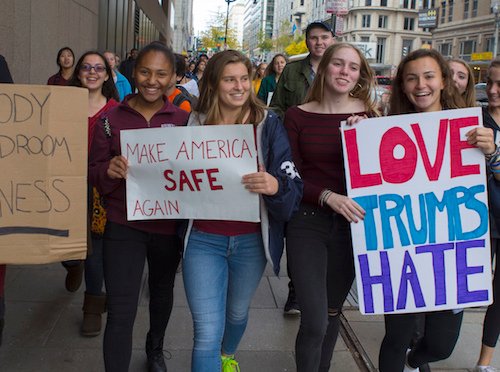It’s no secret that millennials are blue by nature, having become the most well-educated class of Americans and multicultural group to grace the halls of voting locations everywhere.
But apathy aside, it became a tough pill to swallow to actually walk those halls and pull the lever for Hillary Clinton, an establishment figure with almost no charisma or apparent understanding of what ails the kids that hail from what once was known as the middle-class.
So it is that the largest voting bloc in America voted third-party in high percentages, or stayed home all together.
Here’s a snapshot of what the millennials on election day looked like, and how we see things moving forward:
Millennial support for Clinton a double-digit drop from Obama
Back in 2008, Barack Obama’s enthusiasm and message of hope resonated with young voters who turned out in larger than usual numbers to vote for the first black president. He captured a whopping 67 percent of their vote, setting up his successor with a coalition of multicultural youth that values
Eight years later, America’s first female major party candidate only got around 55 percent of votes in the same age group (under-30). That’s a 12 percent drop for a group that voted for Trump by about the same amount as they did for Gov. Mitt Romney in 2012 (37 percent).
Third party support is way up among millennials

Hundreds of students in the nation’s capital walked out of class and headed downtown to protest President-elect Donald Trump. (AP Photo/Jon Elswick)
In spite of having the star power of Hollywood in her corner, and a rash of celebrity appearances to help her mad dash toward the finish line that included the likes of Katy Perry, Beyonce and Jay-Z, and, yes — Bernie Sanders — Clinton lost many millennials to third-party candidates Jill Stein and Gary Johnson.
According to Bloomberg, eight percent of under-30 voters went for one of the two, compared with just 3 percent during Obama’s re-election bid. In some states, such as Arizona, the percentage of third-party support was in upwards of 11 percent.
Millennials are just as focused on getting jobs as social equity
While Trump’s messages of discrimination alarmed many young voters. They overwhelmingly believe in a level playing field; one study also suggests that a millennial would prefer to have a job they loved that paid $40,000 over one that paid $100,000 that they hated.
Other areas of concern: sustainability and climate, global poverty, racial and wage equality, and debt-free college. That doesn’t change the fact that a whopping 51 percent of millennials report being underemployed, lending credence to the image of the college-educated barista.
Trump’s message of job creation may have hit home for the 39 percent of millennials who voted for him, while Clinton’s message never resonated. According to a report by the Mercury News, exit polls show young voters feel a corruption in the system, are depressed by the status quo, and want to vote for change.
“There’s wide recognition that the system isn’t working the way we want it to work,” said 30-year-0ld Elizabeth Holcomb.
